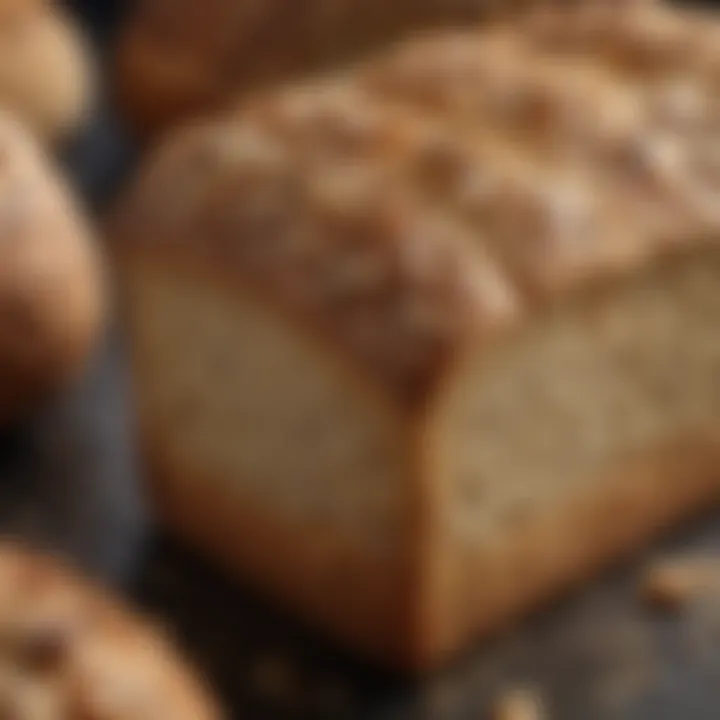Exploring the Best Plant-Based Bread Varieties


Intro
The realm of plant-based bread presents an enticing journey for any enthusiast of healthy eating. Each loaf speaks to a commitment not only to taste but also to well-being and sustainability. As dietary preferences shift globally, understanding the nuances of plant-based bread can significantly enhance one's culinary repertoire.
In this article, we will explore the diverse varieties of plant-based bread, delve into their nutritional benefits, and shed light on innovative preparation techniques. With this comprehensive guide, both novice cooks and experienced chefs will find valuable insights. Furthermore, we will discuss emerging trends in plant-based eating, integrating them into our understanding of bread-making practices.
Let’s uncover the myriad ways in which plant-based bread can satisfy not just daily nutrition, but also creative culinary expressions.
Recipe Overview
Recipe Name
Whole Wheat Vegan Bread
Description of the Dish
Whole Wheat Vegan Bread offers a wholesome alternative to traditional bread. It incorporates nutrient-rich whole wheat flour and natural ingredients that align with a plant-based lifestyle. This recipe yields a hearty loaf that is perfect for sandwiches, toast, or simply enjoyed with a drizzle of olive oil. Its simplicity and flavor make it a fantastic choice for those seeking to explore plant-based baking.
Ingredients
List of Ingredients with Measurements
- 3 cups whole wheat flour
- 1 ½ cups warm water
- 2 tablespoons olive oil
- 2 tablespoons maple syrup or agave nectar
- 1 teaspoon salt
- 2 teaspoons active dry yeast
Special Notes on Ingredients
- Olive oil can be substituted with coconut oil or avocado oil for variation.
- Maple syrup adds sweetness; however, it can be replaced with brown sugar for a different flavor profile.
- Consider using spelt flour as a regional variant; its unique taste can elevate your bread.
"Plant-based bread not only caters to dietary restrictions but also promotes overall health and environmental sustainability."
This detailed understanding of ingredients sets the foundation for making a nutritious bread that lacks common allergens found in animal-based products, facilitating a healthier lifestyle.
Preface to Plant-Based Bread
Plant-based bread has gained attention as more individuals seek healthier, more sustainable eating options. This trend emphasizes the necessity of understanding and exploring plant-based bread varieties, as they can cater to various dietary needs and preferences. In an era where people are increasingly conscious about what they consume, knowing the benefits and nutritional aspects of plant-based options becomes crucial.
Importance and Benefits
Plant-based bread can often provide a plethora of health benefits compared to traditional bread. One of the main advantages is their lower levels of saturated fat, which can serve as a better option for those concerned about cholesterol levels. Furthermore, these breads typically include whole grains and seeds, which contribute to a higher fiber content. This aspect is significant because fiber plays an important role in digestive health, potentially reducing the risk of various ailments.
The variety of plant-based breads allows for unique flavor profiles and textures that can please diverse palates. Whole grain options offer nuttier tastes, while specialty flatbreads can serve as versatile accompaniments to meals. Choosing plant-based bread is not solely about diet; it reflects a commitment to sustainability. Many commercial plant-based breads incorporate ethically sourced ingredients, thereby supporting environmentally friendly practices.
Considerations When Choosing Plant-Based Bread
While exploring plant-based bread, it is essential to consider the ingredients used in each type. Some commercial options may contain additives or preservatives that detract from the overall health benefits. Therefore, reading labels carefully is paramount. When making bread at home, one can control the ingredients, ensuring they align with health goals and tastes.
Nutritional Profile of Plant-Based Bread
The nutritional profile of plant-based bread serves as a central theme in understanding the health benefits and overall appeal of these options. Such breads not only cater to various dietary needs but also emphasize the incorporation of essential nutrients that contribute to a balanced diet. A thorough examination of the macronutrients—namely carbohydrates, proteins, and fats—as well as the vital vitamins and minerals is crucial in evaluating the role of plant-based bread in a healthy lifestyle.
Macronutrients in Plant-Based Breads
Carbohydrates
Carbohydrates are the primary source of energy in plant-based breads. They provide readily available fuel needed for daily functions and physical activity. The presence of complex carbohydrates, particularly in whole grain varieties, distinguishes them from refined bread. Complex carbohydrates digest slowly, leading to sustained energy without sudden spikes in blood sugar levels. They also contribute to digestive health through fiber content, which is beneficial for regular bowel movements.
Some breads may contain added sugars, which can compromise their health benefits. Choosing breads with whole grain flour ensures lower sugar levels and richer fiber content. This makes carbohydrates not only a substantial energy source but also vital for long-lasting satiety.
Proteins
Proteins play a critical role in building and repairing tissues, making them an essential component of plant-based bread. Ingredients like almond flour or chickpea flour can boost the protein content significantly compared to traditional wheat flour. As people increasingly adopt plant-based diets, they search for high-protein options to meet their dietary needs.
Protein quality is another consideration. While plant proteins may be seen as incomplete compared to animal-based proteins, many plant-based breads incorporate a variety of sources that provide complementary amino acids. This approach enhances the nutritional value, making it easier for individuals to get sufficient protein intake. However, attention must be given to the overall balance of macronutrients in one's diet.
Fats
Fats, although present in smaller quantities in plant-based breads, are crucial for flavor and texture. Ingredients such as seeds or nut flours add healthy fats that are beneficial for heart health. Omega-3 and omega-6 fatty acids found in flaxseeds or chia seeds can also provide anti-inflammatory benefits.
Yet, it is essential to be mindful of the types of fats consumed. Trans fats and excessive saturated fats should be avoided, while leaning towards unsaturated fats from natural sources. Therefore, when choosing plant-based bread, selecting products rich in healthy fats enhances the overall nutritional value.
Vitamins and Minerals
B Vitamins
B vitamins are essential in transforming food into energy and play a significant role in brain health. Many plant-based breads, especially those made from whole grains, are rich in B vitamins like niacin, riboflavin, and B6. These vitamins are vital in maintaining metabolic processes and supporting the nervous system.
Inclusion of ingredients such as nutritional yeast can further enhance the B vitamin profile in breads. Regular consumption of B-rich plant-based bread can help prevent deficiencies prevalent in those who do not consume animal products.
Iron
Iron is a critical mineral for oxygen transport in the blood. While animal sources of iron are well-known, plant-based breads can still provide this mineral through ingredients like whole wheat flour or fortified varieties. It is important to note that plant-derived iron, known as non-heme iron, is less readily absorbed by the body compared to heme iron from animal sources.
Combining iron-rich plant-based bread with vitamin C sources, like citrus fruits, can enhance absorption and make these breads a good option for individuals requiring extra iron intake, such as vegans and vegetarians.
Magnesium
Magnesium contributes to over 300 biochemical processes in the body, including muscle function and energy production. Plant-based breads that incorporate whole grains or seeds can be substantial sources of magnesium. Consuming a diet rich in magnesium supports cardiovascular health and may help prevent various chronic diseases.
However, many people do not achieve the recommended magnesium intake. Incorporating magnesium-rich breads can be an easy way to increase dietary intake and enhance overall health.
Plant-based breads provide a myriad of nutritional benefits essential for maintaining a balanced diet. Their focus on whole ingredients and nutrient density makes them a favorable choice for a healthy lifestyle.


Types of Plant-Based Breads
The classification of plant-based breads is essential to understanding their diversity and specific health benefits. Each type brings unique flavors, textures, and nutritional profiles, catering to varying dietary needs and cultural preferences. The selection of bread can significantly impact one's dietary regimen, making it important to explore these distinctions.
Whole Grain Bread
Whole grain bread is a staple in the plant-based category. This type of bread uses the entire grain kernel, which includes the bran, germ, and endosperm. This aspect is significant as it retains valuable nutrients that are often lost in refined bread. Whole grain bread is high in fiber, which aids digestion and helps maintain a healthy weight. Furthermore, it is rich in antioxidants and vitamins, making it a beneficial choice for those seeking nutritious options. Its dense texture and hearty flavor complement various toppings, enhancing any meal.
Sourdough Variants
Sourdough has gained popularity due to its distinct taste and fermentation process. While traditional sourdough uses simple ingredients, gluten-free sourdough offers an alternative for those with allergies. Each variant presents unique possibilities for flavor and nutrition, thus enriching the plant-based bread landscape.
Traditional Sourdough
Traditional sourdough is characterized by its natural fermentation process, which enhances its flavor and texture. The presence of beneficial bacteria helps in better digestion of gluten, making this type popular among those with mild gluten sensitivities. Additionally, the tangy flavor offers a versatile base for various toppings or spreads. However, it may not suit those with strict gluten intolerance.
Gluten-Free Sourdough
Gluten-free sourdough has gained traction as a viable option for individuals avoiding gluten. Made from gluten-free grains and utilizing similar fermentation methods, it aims to replicate the texture and taste of traditional sourdough. This provides a significant advantage for those wishing to enjoy a sourdough-like experience without gluten-related concerns. However, some may find that the flavor profile varies slightly compared to traditional versions.
Flatbreads
Flatbreads feature a simple preparation process that makes them a practical option. They are typically thinner, making them ideal for wraps or sides. Their versatility is an appealing factor, allowing for various applications in plant-based meals.
Pita Bread
Pita bread has a unique pocket design, allowing it to be filled with various ingredients. This characteristic makes it excellent for sandwiches or wraps. Pita bread is made primarily from wheat flour and is lower in calories compared to other bread types, making it a popular choice for those mindful of calorie intake. However, its reliance on wheat may not make it suitable for gluten-free diets.
Lavash
Lavash is another flatbread that is very thin and often larger than pita. It serves well for wrapping meats or vegetables, owing to its pliability. The preparation usually involves simple ingredients and has a slightly chewy texture. Lavash is often used in Middle Eastern cuisine and is often welcomed for its subtle taste, complementing various dishes. On the downside, its thinness may make it less filling in some situations.
Seeded Breads
Seeded breads enrich the nutritional value of bread by incorporating seeds like flaxseed, chia, or sunflower seeds. These seeds enhance fiber content and provide healthy fats, making seeded breads an excellent choice for those prioritizing nutrition. They offer a unique crunch and nutty flavor, adding depth to meals or snacks.
Cultural Varieties
Cultural varieties of plant-based bread showcase the diversity in taste and preparation techniques worldwide. They reflect the culinary traditions of specific regions, contributing to the richness of global cuisine.
Naan
Naan is a popular Indian flatbread, traditionally cooked in a tandoor oven. It is often soft and fluffy, making it a delightful accompaniment to various Indian dishes. The addition of yogurt in the dough gives it a unique taste and texture. However, its preparation often requires special equipment and may not be practical for everyday baking.
Injera
Injera is a staple in Ethiopian cuisine, made from teff flour. This fermented flatbread has a slightly sour taste, making it an excellent base for many stews and salads. It is rich in protein and iron, distinguishing it from many other types of bread. However, its preparation can be time-consuming, requiring a sourdough starter and knowledge of the fermentation process.
Key Ingredients in Plant-Based Bread
Understanding the key ingredients in plant-based bread is fundamental to creating delicious and nutritious options. The selection of ingredients affects not only the taste and texture but also the nutritional profile of the bread. Each ingredient plays a specific role in the process of bread-making.
Flours Used
Wheat Flour
Wheat flour is a primary choice for many bread recipes. This ingredient is rich in gluten, which gives bread its structure and elasticity. The high protein content in wheat flour also supports fermentation, enhancing flavor and texture. An important aspect of grains, it offers a familiar taste that many people enjoy. However, wheat flour may not be suitable for those with gluten sensitivities or celiac disease, which limits its use in diverse dietary practices.
Almond Flour
Almond flour is a popular alternative, especially among gluten-free and low-carb enthusiasts. It is nutritious, low in carbohydrates, and contains healthy fats, making it a good option for health-conscious eaters. The nutty flavor of almond flour provides a unique taste to the bread, appealing to many. One disadvantage is that it can lead to denser textures if not combined properly with other flours.
Coconut Flour
Coconut flour is another beneficial choice known for its high fiber content. It is gluten-free and provides a slightly sweet flavor, which can enhance certain recipes. A unique feature of coconut flour is its ability to absorb large quantities of liquid, which often requires adjustments in recipes. This can be advantageous for creating moist bread but can also complicate the measurement process.
Binders and Leaveners
Flaxseed Meal
Flaxseed meal acts as a natural binder in recipes, useful for maintaining moisture and holding ingredients together. Rich in omega-3 fatty acids, it adds nutritional value. Flaxseed meal forms a gel-like consistency when mixed with water, mimicking the behavior of eggs. However, it has a distinct flavor, which may not suit all palates.
Chia Seeds
Chia seeds serve a similar function to flaxseed meal. When soaked in water, they expand and form a gelatinous texture, providing binding properties. They are notably high in fiber and protein, contributing to the overall nutritional profile of the bread. One challenge is their crunchy texture, which might not be preferable in all types of bread.
Baking Soda
Baking soda is a crucial leavener in plant-based baking. It acts quickly to create carbon dioxide, promoting rising during the baking process. It is versatile and easy to use, making it a favored choice. However, using too much can lead to a soapy taste, affecting the overall flavor profile of the bread.
It's essential to balance your ingredients. The right combination will yield the best taste, texture, and nutritional benefits in plant-based bread.
Understanding the key ingredients provides a foundation for successful and enjoyable baking. Selecting the right flour, binders, and leaveners allows for diverse recipes that cater to various dietary preferences.
Health Benefits of Plant-Based Breads
Plant-based breads have gained attention not only for their flavor profile but also for their contributing health benefits. As more individuals lean towards plant-based diets, the significance of understanding how these breads can impact overall health cannot be understated. This section delves into specific health benefits, including their role in weight management and support for digestive health.
Weight Management
Weight management is crucial for many aspiring to maintain a healthy lifestyle. Plant-based breads can be an excellent addition to one's diet when trying to manage weight. They are often lower in calories compared to traditional breads made with refined flours. Whole grain options are rich in dietary fiber. Here are some ways plant-based breads may assist in weight control:


- Higher Fiber Content: Fiber-rich foods can promote satiety. This means you feel full longer, reducing the desire for snacking, which can lead to better portion control.
- Nutrient Density: Plant-based breads typically contain more vitamins and minerals than their white bread counterparts. This increases the body's nutrient intake without excessive calories.
"Choosing the right type of bread can either support or hinder weight management goals; plant-based options generally support better choices."
Digestive Health
The digestive system benefits significantly from the components found in plant-based breads. Consumption of these breads can promote better gut health, which is essential for overall well-being.
- Probiotics in Sourdough: Some variants of plant-based breads, especially sourdough, may contain probiotics due to the fermentation process. Probiotics support a healthy gut microbiome, aiding digestion and enhancing nutrient absorption.
- Soluble and Insoluble Fiber: Both types of fiber are present in whole grain options. Soluble fiber slows digestion, allowing for better nutrient absorption. Insoluble fiber adds bulk to stool, facilitating regular bowel movements and preventing constipation.
- Reduced Processed Ingredients: Many plant-based breads are void of additives and preservatives common in conventional breads. This can reduce the likelihood of digestive irritations for sensitive individuals.
In summary, incorporating plant-based breads into the diet offers numerous health benefits, particularly concerning weight management and digestive health. These breads form a crucial part of a balanced diet, ensuring nutritional needs are met while supporting healthy weight goals and digestive systems.
Making Plant-Based Bread at Home
Making plant-based bread at home can be a fulfilling endeavor. It gives individuals control over the ingredients and flavors, assuring that the final product aligns with personal preferences and dietary needs. Home baking promotes creativity and can tailored to specific health goals, such as lower sugar or gluten-free options.
Basic Techniques
Mixing Ingredients
Mixing ingredients is a critical first step in bread-making. This process is essential as it ensures all components blend thoroughly to create a uniform dough. The primary characteristic of mixing is its role in activating certain elements needed for proper texture and flavor. When flour combines with water, gluten begins to form, offering structure to the bread.
A beneficial aspect of mixing ingredients is that it allows for the incorporation of various flavors. Adding herbs, seeds, or even fruits can be integrated at this stage. Its unique feature lies in the freedom it provides to customize the bread to individual tastes. However, over-mixing can lead to a dense and chewy texture, which some may find unappealing.
Kneading Dough
Kneading dough is another fundamental process in bread production. This action helps develop gluten further, giving the bread its chewy texture. Kneading not only contributes to the dough's elasticity but also helps evenly distribute air throughout the mixture.
The key characteristic of kneading is the physical manipulation of the dough. It is a beneficial choice because it allows the baker to feel the texture and adjust moisture levels as needed. One unique feature of kneading is its ability to transform a shaggy mass into a smooth dough ball. However, improper kneading can result in either underdeveloped or overworked dough, both of which could compromise the bread's structure.
Baking Methods
Oven Baking
Oven baking is one of the most common methods used for making plant-based bread. This approach works by surrounding the dough with hot air, leading to even cooking. The key characteristic of oven baking is its ability to provide consistent temperature control. It is a beneficial choice as it allows for a variety of bread types to be baked effectively.
A unique aspect of oven baking is the Maillard reaction, which occurs when sugars and amino acids react under heat. This process creates the crust and contributes to the bread's flavor. However, one disadvantage could be related to energy consumption, as baking may require significant power depending on the oven used.
Steam Baking
Steam baking is another method that can elevate plant-based bread. This technique involves introducing steam into the oven, which helps maintain moisture around the dough. The main characteristic of steam baking is that it enhances crust formation and elasticity. This makes it a highly beneficial method for specific types of bread, especially artisanal ones.
A significant benefit of steam baking is that it can keep the inside softer while providing a crisp crust. However, it can be slightly more complex to execute, as it requires additional equipment or methods to generate steam effectively. Balancing moisture levels is crucial, as too much can lead to a gummy texture, which is undesirable.
"Baking bread at home not only connects you with the process, but also enhances your cooking skills. It can be as simple or complex as you choose."
Popular Trends in Plant-Based Bread
The realm of plant-based bread is continually evolving. Trends emerge as consumer tastes shift towards healthier and more sustainable dietary choices. Understanding these trends is essential. They signal not just what people want to eat, but also how the industry responds to those preferences.
Among these trends, gluten-free options stand out. Many consumers are increasingly avoiding gluten due to allergies or intolerances. This demand has led to innovation in recipes and production methods. In this article, we explore why gluten-free bread is important to many subject to dietary restrictions. Furthermore, high-protein variants are gaining popularity as fitness-focused consumers seek to enhance their diet without compromising their preference for plant-based foods. Such trends demonstrate how the market adapts to the evolving needs of the health-conscious public.
"The increasing interest in plant-based options reflects a broader dietary paradigm shift towards sustainability and wellness."
Gluten-Free Options
Gluten-free bread has become a staple in many households. The rise of gluten intolerance awareness among people has increased the need for alternatives. Common ingredients include almond flour, chickpea flour, and coconut flour. Each offers unique taste profiles and nutritional benefits.
The taste and texture of gluten-free bread have improved significantly. No longer are these options dense and dry. Now, they successfully replicate the qualities of traditional bread. Brands like Udi's and Canyon Bakehouse focus on this improvement. They design products that cater to both gluten-sensitive and general audiences. Consumers find themselves enjoying a broader selection, making gluten-free appealing. The popularity of these options reflects an inclusive approach to dining where everyone can share in a meal.
High-Protein Variants
High-protein plant-based breads cater to those seeking muscle recovery and overall health maintenance. Often made with protein-rich ingredients, such as pea protein and hemp seeds, these breads offer substantial benefits to athletes and active individuals. This approach allows for the inclusion of complex carbohydrates while ensuring adequate protein intake.
As fitness culture continues to grow, high-protein bread appeals to a vast audience. Brands like Dave's Killer Bread have responded effectively by creating variants that couples taste with nutritional value. This trend highlights consumers’ desires for food that not only sustains energy but also supports their active lifestyles.
The integration of gluten-free and high-protein options demonstrates an adaptable market that recognizes consumers' diverse needs. Plant-based bread is no longer just an alternative. It is a product designed to fulfill specific dietary goals, making it an exciting area for further exploration and innovation.
Pairing Plant-Based Bread with Meals
Pairing plant-based bread with meals is essential in creating a balanced and satisfying dining experience. This section will explore how different types of bread can complement various dishes, enhancing flavors and textures. When choosing the right plant-based bread, it is important to consider the ingredients and nutritional value to ensure that the pairing contributes positively to the meal. The right combinations can elevate simple dishes to something remarkable by adding depth and richness.
Breakfast Combinations
Breakfast is often seen as the most important meal of the day, and incorporating plant-based bread can make it both nutritious and satisfying. Light, airy breads can go well with fresh spreads or toppings. For example, a slice of whole-grain bread spread with avocado can provide healthy fats and fiber, while adding a dash of salt and pepper enhances the flavor.
Here are some popular combinations for a plant-based breakfast:
- Avocado Toast on Whole Grain Bread: Rich in healthy fats and fiber, this is a classic breakfast that many enjoy. Adding tomatoes or radishes can increase nutrients.
- Peanut Butter on Seeded Bread: This offers protein and keeps you full for longer. Top with banana slices for added sweetness and potassium.
- Smoothie Bowl with Toast on the Side: Whole grain or seeded bread can be served alongside a colorful smoothie bowl. The contrast of textures is delightful.
- Sourdough French Toast: Using plant-based milk and a flaxseed mixture, this can be a deliciously warm breakfast.
The key is to balance flavors and nutritional content. Each combination should aim to provide lasting energy for the day ahead.
Lunch and Dinner Meals
Lunch and dinner meals can greatly benefit from thoughtful pairings with plant-based bread. The type of meal dictates the bread choice, making it significant in meal preparation. Bread can add body to salads or even serve as a vessel for soups.
Here are some combination suggestions for lunch and dinner:
- Bruschetta on Sourdough: Topped with tomatoes, basil, and a drizzle of balsamic vinegar, this mix offers a refreshing burst of flavor, suitable as an appetizer or side.
- Pita Bread with Hummus and Vegetables: This plant-based choice is versatile, allowing you to load it with fresh vegetables and protein-rich hummus.
- Grilled Vegetable Sandwich on Whole Grain Bread: Incorporating an assortment of grilled vegetables brings umami, and layers of flavors, balanced perfectly by the bread’s texture.
- Naan with Curry: Soft naan serves as an excellent accompaniment to savory, fragrant curries, soaking up the sauces effectively.
In planning meals involving plant-based bread, think about harmony in flavors, textures, and nutritional balance. This can create a complete meal that satisfies and nourishes.


Storage and Preservation Techniques
Proper storage and preservation techniques for plant-based bread are essential for maintaining freshness, flavor, and nutritional value. These methods allow bread enthusiasts to enjoy their favorite baked goods without compromising quality. Various factors influence the longevity of plant-based bread, such as ingredients, moisture content, and environmental conditions. Therefore, implementing the right techniques plays a crucial role in maximizing shelf life and minimizing waste.
Freezing Methods
Freezing is one of the most effective ways to prolong the freshness of plant-based bread. This method significantly slows down the staling process, allowing bread to retain its taste and texture for a more extended period. Here are some key points to consider when freezing plant-based bread:
- Preparation: Slice the bread before freezing. Individual slices allow for easier thawing and portion control.
- Packaging: Wrap the bread in plastic wrap or aluminum foil to protect it from freezer burn. For extra protection, place the wrapped bread inside a resealable freezer bag.
- Timing: Consume the bread within three months for optimal quality. While frozen bread remains safe to eat beyond this period, taste and texture may deteriorate.
To thaw, simply remove the desired slices from the freezer and let them sit at room temperature. For quicker results, using a toaster or microwave is also an option.
Freezing plant-based bread correctly can preserve its quality, making it convenient for those who bake in larger batches.
Shelf Life Considerations
Understanding the shelf life of plant-based bread is paramount for storing these goods effectively. Factors that affect shelf life include:
- Ingredients: Whole grain and seeded breads tend to spoil faster due to their natural oils. Conversely, breads made with preservatives may last longer.
- Storage Conditions: Keep the bread in a cool, dry place to prevent mold growth. Avoid exposure to heat and humidity.
- Types of Packaging: Using breathable bags can help manage moisture. If bread is kept in a sealed container, check for condensation, which can lead to spoilage.
In general, homemade plant-based bread should be consumed within three to seven days when stored at room temperature. If you anticipate longer storage needs, freezing is the preferred method for maintaining quality.
Exploring Commercial Plant-Based Bread
The rise of plant-based eating has led to an increased interest in commercial plant-based bread. This trend goes beyond mere dietary preference; it reflects a significant shift in consumer attitudes toward health and sustainability. Commercial plant-based bread provides an accessible means for individuals to incorporate healthier options into their diet without drastic changes to their eating habits. Exploring this category can reveal a wealth of benefits, including the variety of options available, the nutritional advancements made in bread production, and the growing acceptance of these choices in mainstream diets.
Brand Overview
Several brands have emerged in the commercial plant-based bread market. These brands have distinct approaches to their products, ranging from organic ingredients to gluten-free options. Some well-known names include Ezekiel Bread and Dave's Killer Bread. They often focus on whole grains and minimal processing. Each brand's unique offerings make it important for consumers to consider their individual preferences and dietary needs.
When selecting a brand, consumers should pay attention to the ingredients list. Breads that highlight whole grains, seeds, and natural preservatives can be more beneficial than those with artificial additives. This is fundamental for those looking to maintain a healthy lifestyle while still enjoying their bread. Additionally, the sourcing of ingredients is crucial, as brands that prioritize high-quality, sustainable farming practices often yield better nutritional profiles.
Consumer Preferences
Consumer preferences in plant-based bread reflect broader trends toward healthier eating. Many individuals are seeking products that align with their lifestyle choices. Factors influencing preferences include:
- Nutritional Benefits: Many consumers prefer breads that offer significant health advantages, such as high fiber content and low glycemic index.
- Taste and Texture: Taste remains a critical component. Customers are drawn to breads that do not compromise on flavor, even when made from alternative ingredients.
- Label Transparency: A growing number of consumers demand clear labeling. They want to know the source of their food, which fosters trust in the product and brand.
- Sustainability: Environmental concerns drive many purchases. Brands that adopt eco-friendly practices find favor among consumers who prioritize sustainability.
Understanding these preferences helps brands tailor their products to meet the demands of a more conscious consumer base. As plant-based diets gain popularity, it is essential for both producers and consumers to engage in an ongoing dialogue about quality, sustainability, and health.
Challenges in Plant-Based Bread Production
In the evolving landscape of culinary practices, plant-based bread stands out for its health benefits and dietary versatility. However, producing high-quality plant-based bread is not without its challenges. Understanding these challenges is vital for both consumers and producers as they navigate the complexities of ingredient selection, baking techniques, and consumer preferences.
Ingredient Sourcing
Sourcing the right ingredients is fundamental to creating successful plant-based bread. Unlike traditional bread that primarily relies on wheat gluten, plant-based options often encompass a range of ingredients such as alternative flours, seeds, and natural leaveners. This diversity poses several challenges.
- Quality Control: Ensuring consistent quality among different suppliers can be difficult. Variability in the properties of flours, for example, affects hydration levels and dough behavior.
- Availability: Certain ingredients may not be readily available in all regions, limiting options for bakers. Notably, some ingredients are also seasonal, making them intermittent in availability.
- Cost Factors: Specialty ingredients, like almond or coconut flour, can be considerably more expensive than traditional flours. This can impact the pricing of finished products, making them less accessible to a broader market.
Finding reliable sources that offer sustainably harvested ingredients is crucial. Building relationships with suppliers who prioritize fair practices and sustainability can enhance the overall quality of plant-based bread.
Maintaining Texture and Flavor
Texture and flavor are two critical elements that define bread quality. Plant-based bread often struggles to replicate the familiar textures and flavors associated with traditional bread. Achieving these characteristics requires careful consideration and innovation.
- Texture Challenges: Without gluten, achieving the desired elasticity and chewiness can be a significant hurdle. Bakers often experiment with various binding agents such as flaxseed meal or aquafaba to improve the texture of their bread. Finding the right balance can take time and experimentation.
- Flavor Profile: Plant-based ingredients can impart different flavors compared to wheat-based breads. While some consumers may enjoy these diverse flavors, others may find them unappealing. Developing a robust flavor profile is crucial and might involve incorporating herbs, spices, or nuts to enhance taste.
"The ability to master texture and flavor can differentiate a successful plant-based loaf from its conventional counterparts."
In summary, the challenges of ingredient sourcing and achieving the right texture and flavor are significant in plant-based bread production. Understanding these challenges helps inform consumer choices and encourages producers to innovate.
By addressing these critical issues, producers can improve their offerings, ultimately leading to wider acceptance and enjoyment of plant-based bread.
Consumer Trends in Plant-Based Eating
Plant-based eating is gaining significant momentum in today's society. This trend goes beyond mere dietary choices. It reflects a deeper understanding of health, sustainability, and ethical considerations among consumers. As more individuals become aware of the benefits associated with plant-based diets, demand for innovative food products, including plant-based bread, skyrockets. These trends shape the industry, influencing both producers and consumers alike.
Rising Demand
The rise in demand for plant-based products stems from various factors. First, health awareness among consumers increases daily. Individuals are looking for alternatives to conventional bread that offer better nutritional profiles. Whole grain options and those high in fiber are particularly favorable. According to research, many consumers are shifting to plant-based diets to enhance their overall health. This includes better digestion and weight management.
Second, there are demographic shifts at play. Younger generations, especially millennials and Gen Z, prioritize sustainability and health. They are more inclined to support brands that align with their values. This demographic has been instrumental in creating a market for plant-based bread. Bakery brands need to respond to this trend by offering diverse options and flavors.
"Consumer preferences are reshaping not just what we eat but how we feel about food."
Sustainability Considerations
Sustainability is a critical aspect that drives consumer interest in plant-based eating. People are increasingly conscious of their food's environmental impact. Plant-based diets typically have a lower carbon footprint compared to animal-based foods. Bread made from whole grains, seeds, and legumes requires fewer resources. This appeals to those looking to make environmentally responsible choices.
Moreover, brands that focus on sustainable sourcing of ingredients resonate well with consumers. They prioritize transparency, seeking assurance that their food choices support eco-friendly practices. Community-supported agriculture and local sourcing are becoming popular as consumers want to establish a connection with their food.
Additionally, the aspect of reducing waste in food production influences consumers. More people are engaging with brands that adopt zero-waste policies in packaging and production processes. This creates a demand for innovative solutions in the production of plant-based bread products.
In summary, the trends in plant-based eating highlight an evolving marketplace. Rising demand coincides with sustainability considerations, shaping how consumers view their food choices. This overarching interest presents opportunities for innovation in the realm of plant-based bread.
Ending: The Future of Plant-Based Bread
The landscape of bread is at a pivotal juncture, especially with the rise in plant-based eating habits. The importance of exploring plant-based bread goes beyond mere dietary choices. As more people become aware of health factors and environmental sustainability, the demand for plant-based options is likely to increase. This shift could lead to a revolution in the bread industry, influencing not only how bread is made but also the types of ingredients that are sourced.
One significant aspect of plant-based bread’s future is consumer education. With much information available, understanding the nutritional benefits and culinary versatility of plant-based ingredients is key. As more consumers prioritize health and ethical considerations, the recipe development among bakers will need to adapt.
Evolving Recipes and Techniques
The evolution of recipes and techniques in plant-based bread-making is already underway. Home bakers and professional chefs alike are experimenting with unique combinations of flours, seeds, and other plant-based ingredients. This experimentation can lead to healthier and more flavorful breads.
- Innovative Ingredients: With the exploration of alternate flours like chickpea flour and quinoa flour, bakers are broadening their horizons. These flours not only add nutritional value but also distinct flavors.
- Techniques: As technology improves, new baking techniques are emerging. For instance, the use of fermentation processes has gained popularity. This not only affects the taste but enhances digestibility.
- Cultural Influences: A fusion of traditional methods with modern sensibilities is on the rise. Recipes will increasingly reflect global influences, showing the adaptability of plant-based bread across cultures.
In summary, the future of plant-based bread is bright. It will continue to evolve with changing consumer needs and preferences. The embrace of innovative recipes and baking techniques promises to keep this category dynamic and relevant. The necessity to listen to market trends will be crucial for both large brands and artisanal bakers. In the end, the growth of the plant-based bread sector is not merely a trend; it is an essential part of the future culinary landscape.







